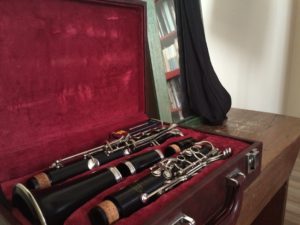
About ten years ago, I discovered 1920s and 1930s traditional jazz. The mix of cornet, trombone, and clarinet with the piano, string bass, and guitar (or tenor banjo) was exhilarating. I was already familiar with the clarinet from listening to Benny Goodman and his big band swing of the 1940s, but when I heard the New Orleans hot jazz sounds of Sidney Bechet, I thought, wow, this instrument doesn’t just make music…it sings right through your soul. It’s that feeling that makes the hair stand up on your arms and a tickle run down your spine.
Even though I was dying to try the clarinet and make those sounds, I found excuses not to. I was already learning to play the violin, and besides, didn’t I already also have a piano that was collecting dust? Never mind the ukulele I’d just purchased that I had only learned five chords on. Besides, where I would I get a clarinet? So about ten years passed.
This past March, I decided it was time. After all, I was an adult, and no one was around to tell me to eat my vegetables before eating my dessert. There are worse vices to try. The clarinet couldn’t kill me. (Although later on I would discover it could drive me insane.) So I rented one from the local music shop, along with a beginner’s book, and all its strange accessories such as a silk swab and cork wax (not to be mistaken for lip balm).
I had a lesson scheduled for the following week, but I couldn’t wait to try it. After ten years, I finally had a clarinet in my hands. As soon as I got home, I googled the pros and cons of wetting the reed with my saliva versus water, and the intricacies of how to position it on the mouthpiece. After about twenty minutes of getting nothing but the sound of forced air, I managed to make the first sound.
The first couple of months I took lessons, I made significant progress, even though I had managed to pick an instrument that was even more difficult to play than the violin. My teacher told me I was able to successfully make that “true” clarinet sound better than most beginners. Maybe I was a natural, I thought. I was encouraged to keep trying. After a few months, I could pick out simple tunes by ear. It turns out that “When the Saints Go Marching In” conveniently uses all the notes from the middle C up to the G.
Then life got in the way. My partner, Daniel, and I were getting the house ready to sell for our move from Austin to Arlington, Texas. I didn’t practice for nearly a month. When I returned to practicing, I was a bit rusty, but I found I was still able to play those comfortable C, D, E, F, and G notes pretty well. Hell, I could just master “When the Saints Go Marching In” and sound pretty damn good at it at most traditional music jams.
 But that would be too easy. Oh no, it was time to take it up a notch. Not only did I need to have the proper embouchure (how my mouth fits on the mouthpiece) and the right arc to my fingers around the body of the clarinet to cover the tone holes and press the right keys—I also needed to maintain precise command of my tongue on and off the tip of the reed (a technique known as “tonguing” to stop the air flow between the notes). I had to do all these things at once. And then I had to learn to get to the next register to make it from the middle C to the next C a full octave up, which involves every single finger. This tonguing and fingering business was far from sexy. I sounded like a dying duck in heat.
But that would be too easy. Oh no, it was time to take it up a notch. Not only did I need to have the proper embouchure (how my mouth fits on the mouthpiece) and the right arc to my fingers around the body of the clarinet to cover the tone holes and press the right keys—I also needed to maintain precise command of my tongue on and off the tip of the reed (a technique known as “tonguing” to stop the air flow between the notes). I had to do all these things at once. And then I had to learn to get to the next register to make it from the middle C to the next C a full octave up, which involves every single finger. This tonguing and fingering business was far from sexy. I sounded like a dying duck in heat.
I will admit, playing the clarinet isn’t very fun right now, and I have felt like quitting the last couple of weeks. It seems impossible to get it all right, and I only manage to make that “true” clarinet sound here and there, by accident it seems. My fingers and my bottom lip gets tired, and my brain can’t keep track of the half a dozen things I need to keep in place. It will be at least five years before I’m ready to play with other musicians in a social setting.
But I will stick with it because I’ve been through this before. It’s easy to play that familiar tune using the notes you’re already comfortable with. Yeah, it’s going to sound pretty good, but the tune gets boring after awhile. At some point, you have to push yourself. You have to sound horrible and feel like you have no idea what you’re doing.
My teacher reminds me not to focus on the notes I get wrong—it’s so easy to make a bad note and feel stuck there. He reminds me to look at the day as a whole…and the notes that I played well. And even though I don’t seem to be making progress day to day, a few months from now, I’ll start to notice progress. A few years from now? Well, who knows. But I know this much. I’ll be able to play more than one tune.
